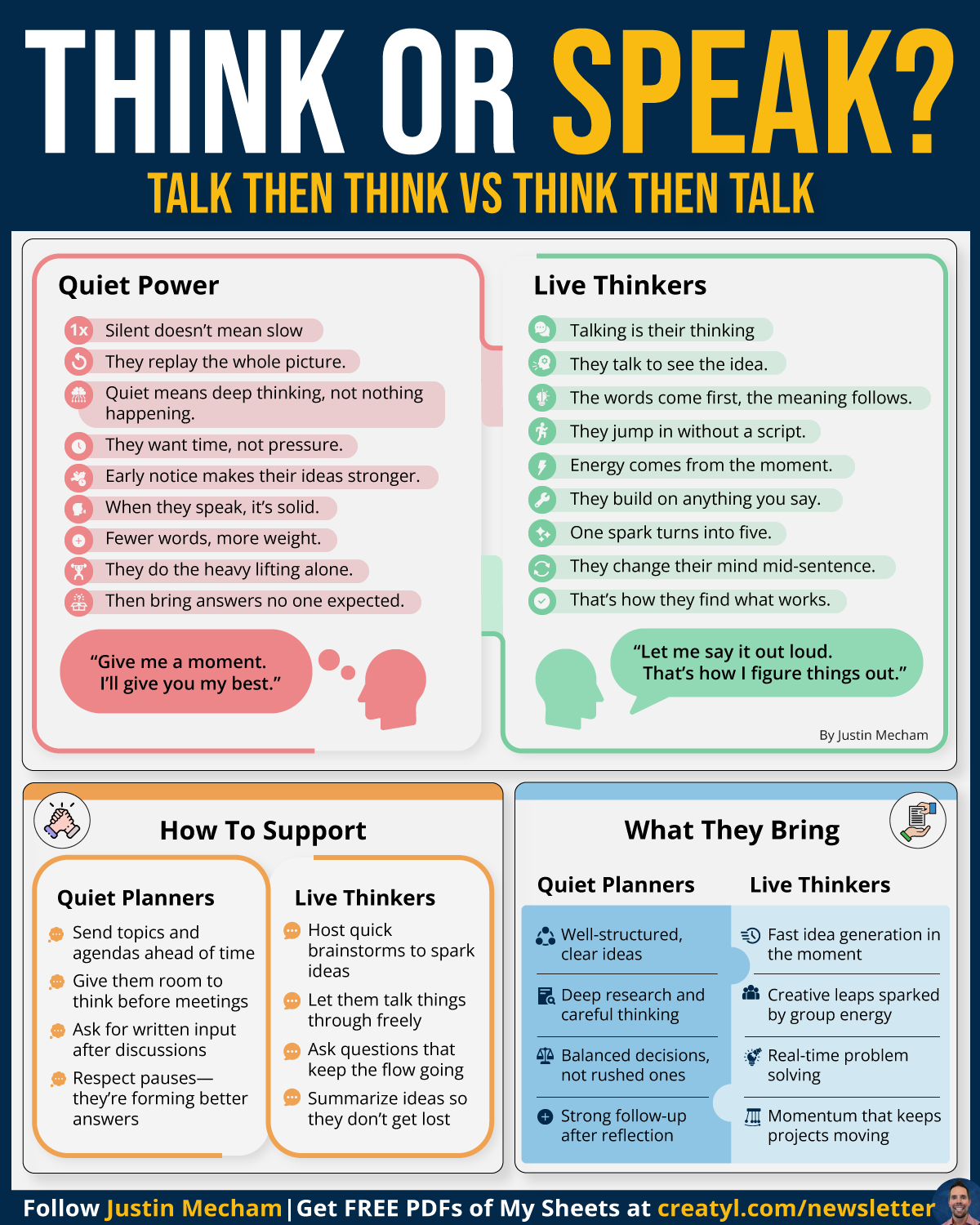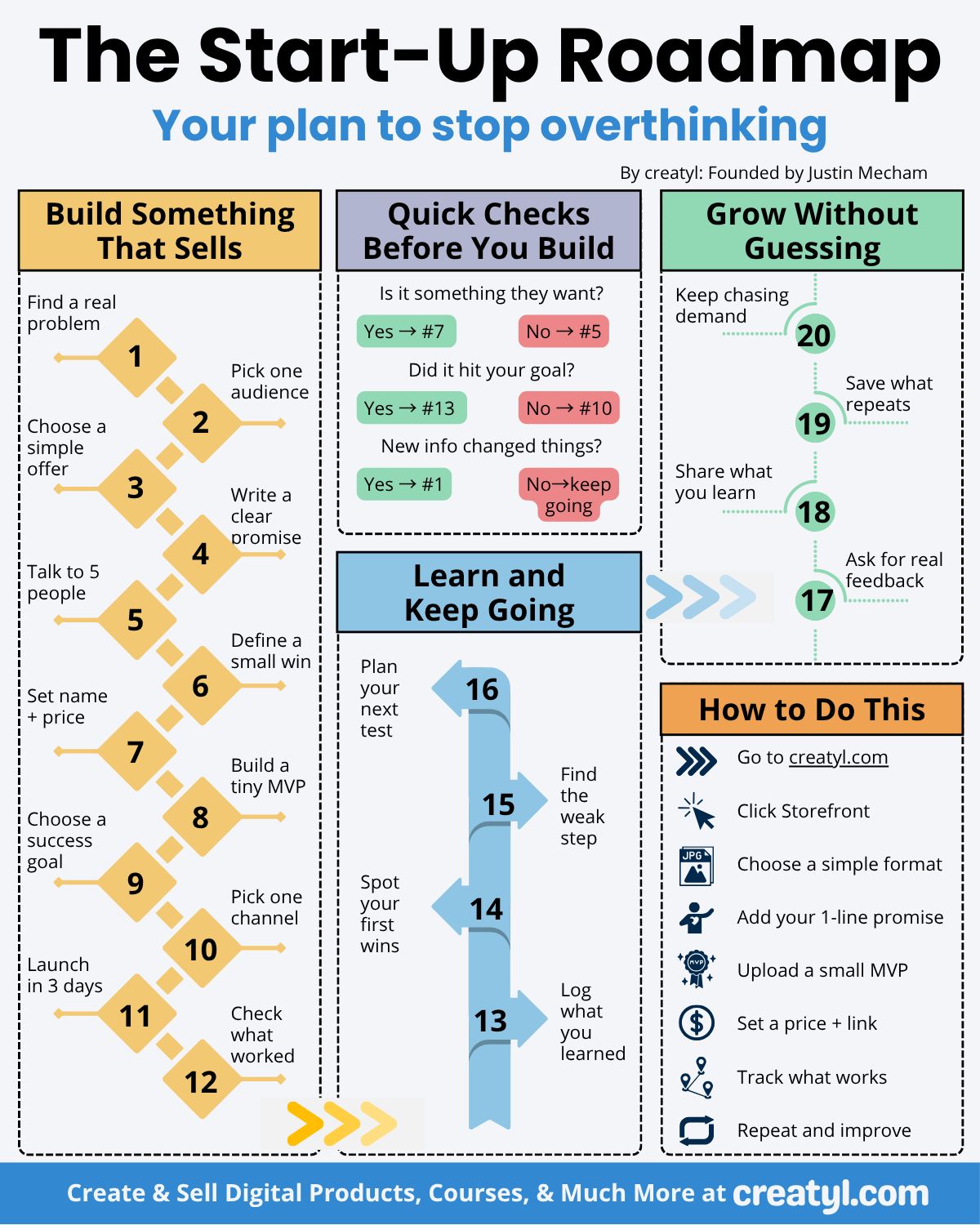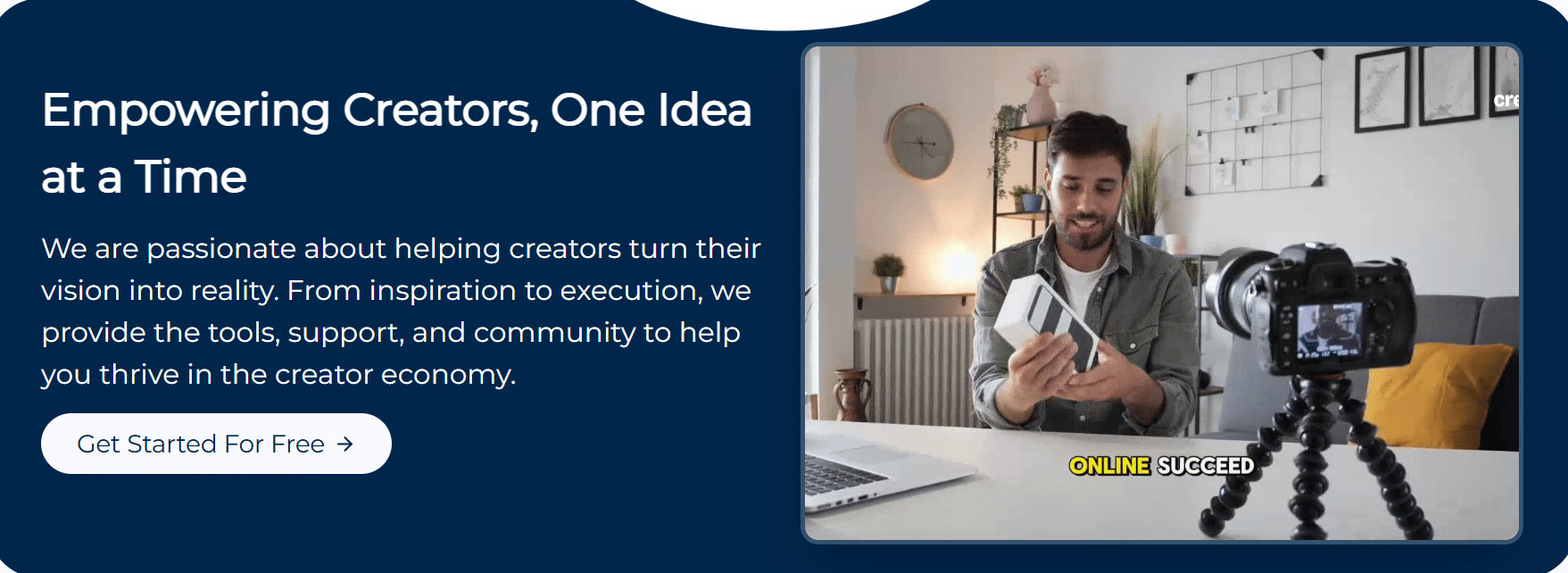Hey Full Potential Zoners,
Silence ≠ weakness, talking ≠ noise— they’re just two ways of thinking.
Some people think first, then talk.
Others talk first, then think.
Both are useful— just in different ways.
I have made incredible money from creating courses once and selling them over and over.
Join my free workshop on Thursday to come learn exactly how I do it and build yours with me live.
✅ A real course fully done, not just a plan
✅ A simple, clear path to start selling the same day
You’ve done enough thinking.
Let’s build it together.
Use my sheet to know how to work better with each.
Great teams aren’t built on one style, they’re built on the strengths of both.
That balance is where the best ideas live.
Today we are going to help leaders master this by using:
‘Think or Speak? - Talk Then Think vs Think Then Talk'.
Let’s dive in!


Download This PDF + my Top 60+ Cheat Sheets At Bottom of Email
How to Handle Thinkers and Talkers at Work
1. You're waiting for someone to speak up in a meeting... but they don’t.
Scenario: A quiet teammate is sitting through the whole meeting silently. You assume they have nothing to say.
Don’t call them out in the moment. That adds pressure, not clarity.
Follow up afterward with a private message like:
“I’d love to hear your thoughts once you’ve had a moment to think it through. Feel free to message or send a short doc.”
Give them a purpose:
Ask them to review one key part, not everything.
Build a habit:
Add a “quiet follow-up” step after team meetings — a shared doc, short form, or even voice notes.
It gives time, clarity, and safety — their zone of strength.
2. You’re stuck brainstorming with someone who says everything out loud.
Scenario: You’re in a creative meeting and your teammate keeps saying half-formed ideas out loud — fast and scattered. You need clarity, not chaos.
Grab a notepad or open a doc.
As they speak, jot the key points down. This keeps you grounded.
Say:
“Okay, here’s what I heard so far — let me read it back. Does that sound right?”
Ask them to choose one direction to explore deeper.
“Out of all of those, which one excites you the most to run with right now?”
Live thinkers often just need someone to mirror their thoughts back. That’s where clarity shows up.
3. Your team has both styles — and it’s slowing things down.
Scenario: Half your team wants to “just start talking.” The other half wants to “go think and come back.” Tension is rising.
Split the session into 2 parts:
Part 1: Live brainstorm (no pressure to decide anything).
Part 2: 24-hour pause, then a follow-up doc or short sync to finalize.
Say clearly:
“We’re using both styles. First we throw ideas around. Then we pause, think, and circle back to make a call.”
Give roles:
Assign a notetaker during live talk so ideas don’t get lost. Assign a reviewer to refine key ideas afterward.
It respects speed and depth. And people stop arguing about who’s “doing it right.”


Download this infographic at the end of this section
You don’t need a long plan. You need a real start.
Most people stay stuck because they’re trying to perfect the whole map.
These 3 real-life moves will help you stop guessing — and finally start building.
Pick the one that fits you best:
1. You’re Ready to Start From Zero
Scenario: You want to sell from what you already know — now, not someday.
Go to creatyl.com
Upload a simple PDF or link
Set a price, send it to 5 people, and ask: “Is this useful?”
2. Too Many Ideas, Still Nothing Live
Scenario: You’ve got 12 product ideas and no clue where to start.
Pick the one you’ve already talked about with real people.
Ask 5 people: “Would this help you right now?”
Write the promise using their words — then move.
Want the deep dive and printable PDF? Click here
Tweaking the idea.
Saving the file.
Fixing the colors.
Changing the name.
Still no product.
Still no sales.
Still not live.
creatyl helps you skip all that.
Drop in your idea (even if it’s messy)
Upload one thing — PDF, doc, template, whatever
Set a price and go live in minutes
No setup. No tech mess.
No waiting for “someday.”

Here's how you can make it real today:
Step 1: Pick your moment
Think about one moment recently when...
Someone didn’t speak up until later (or not at all)
A meeting got messy from too much talking and not enough thinking
You felt unheard, rushed, or misunderstood
Now choose one part of that situation you’d handle differently today.
Step 2: Set your test time
Pick one spot in your day where you’ll try something different:
After your first meeting
During a 1:1 or team brainstorm
Right before replying to a message
Add a sticky note or calendar nudge:
“Try a new thinker/speaker move.”
Step 3: Make your small shift
Choose one move based on the type of thinker/talker you're working with:
If you’re the quiet one: Speak one idea earlier than usual — even if it’s half-formed.
If you talk to think: Pause for 5 seconds after someone finishes speaking before you reply.
If you're leading: Ask someone directly (but gently) for their input after the meeting.
If you’re in a group: Try summarizing what was said — it helps both sides feel seen.
Step 4: Notice what shifted
After the moment passes, pause for 30 seconds.
Ask:
Did something feel easier?
Did the conversation feel more balanced?
Did anyone open up more?
Write down one thing you noticed.
Step 5: End your day with one line
Before your day ends, complete one of these:
“Today I saw the value of thinking/talking differently when ____.”
“Next time I want to work better with a different thinker, I’ll try ____.”
AI Prompt: “Act as a communication coach. Create a practical action plan to help me apply today’s “Think or Speak?” challenge in real conversations.
Here are my details to guide you:
My communication style: [Talks to think / Thinks before speaking]
Common workplace setting: [Team meetings / 1:1s / Brainstorm sessions / Slack or email chats]
Recent challenge: [Describe a moment when communication felt off — e.g., “I couldn’t get a word in,” or “My ideas came out unclear.”]
Goal for today: [e.g., “Balance talking and listening,” or “Help quieter teammates share more.”]
Provide:
A short step-by-step plan I can follow today to apply the challenge.
Simple examples of what I can say or do differently during that moment.
Tips for how to reflect afterward so I can learn what worked and what didn’t.
One reminder I can keep in mind throughout the day to stay aware of my communication habit.
Keep it short, clear, and easy to use during a normal workday.”

Some people talk to think. Some think to talk.
Neither is smarter. Neither is slower.
What looks like hesitation is often depth.
What sounds like rambling is often discovery.
Work gets better when we make space for both.
Until next time and with lots of love,
Justin

This Week’s Growth Recommendations
Book To Read:
“Quiet: The Power of Introverts in a World That Can't Stop Talking” by Susan Cain (see it here)
TED Talk to Watch:
“Think before you speak, hacking the secret of communication" by Catherine Molloy (see it here)

🤖 Be sure to check out my AI-Powered Leader online course - it’s the #1 digital course on how to master AI.
🎨 Want to create infographics and more just like me?
🔥If you have ever thought of building and selling digital products/courses and turn your knowledge into income, it’s much easier than you think.
📑 Today’s PDF
Download today’s PDF by Clicking Here
📑 Justin’s Top 60+ Cheat Sheets
Download All 60+ PDFs by Clicking Here
Were you forwarded this email? Subscribe and get my free eBook Click Here
Want to Sponsor this newsletter or a LinkedIn post? Click Here




